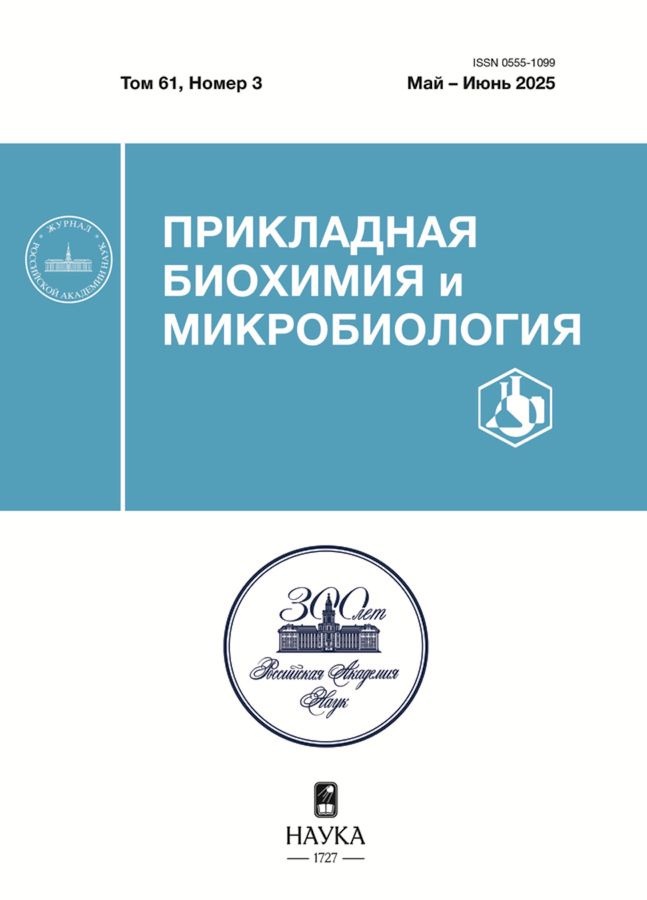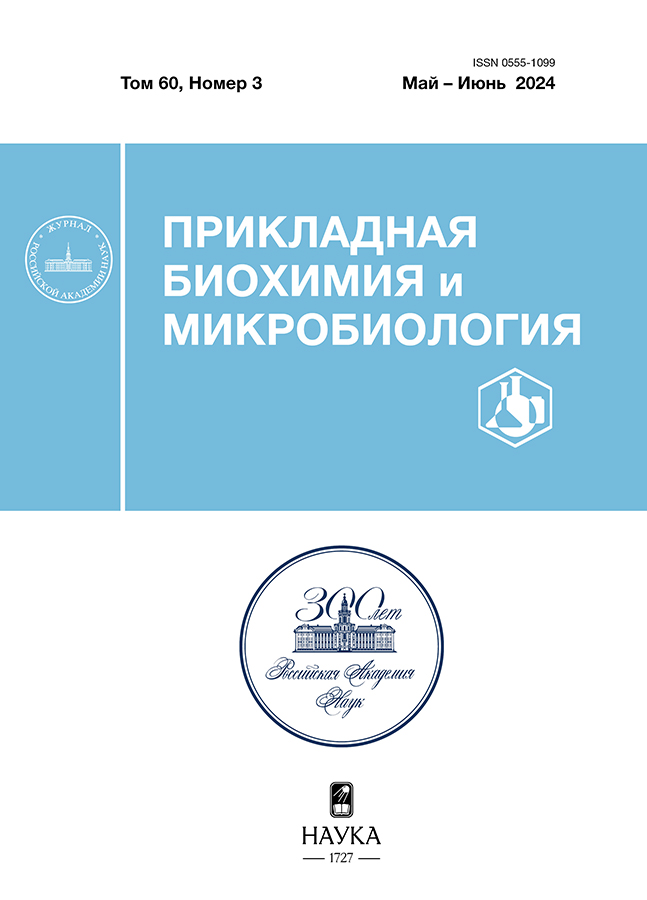Эффект интенсификации цикла трикарбоновых кислот на биосинтез адипиновой кислоты штаммами Escherichia coli по обращенному β-окислению жирных кислот
- Авторы: Гулевич А.Ю.1, Скороходова А.Ю.1, Дебабов В.Г.1
-
Учреждения:
- Федеральный исследовательский центр “Фундаментальные основы биотехнологии” Российской академии наук
- Выпуск: Том 60, № 3 (2024)
- Страницы: 246-253
- Раздел: Статьи
- URL: https://cardiosomatics.ru/0555-1099/article/view/674551
- DOI: https://doi.org/10.31857/S0555109924030033
- EDN: https://elibrary.ru/EXDGUH
- ID: 674551
Цитировать
Полный текст
Аннотация
С использованием в качестве базового ранее сконструированного адипат-секретирующего штамма Escherichia coli MG1655 lacIQ, ∆ackA-pta, ∆poxB, ∆ldhA, ∆adhE, PL-SDφ10-atoB, Ptrc-ideal-4-SDφ10-fadB, ∆fadE, PL-SDφ10-tesB, ∆yciA, Ptrc-ideal-4-SDφ10-fabI, PL-SDφ10-paaJ, ∆aceBAK, ∆glcB получены штаммы-производные, способные к повышенному синтезу целевого соединения из глюкозы по обращенному пути β-окисления жирных кислот. Такой эффект достигнут при интенсификации в клетках цикла трикарбоновых кислот. Прекращение множественных обращений цикла за счет инактивации в штамме сукцинатдегидрогеназы не оказывало выраженного влияния на формирование рекомбинантом адипиновой кислоты. При интенсификации цикла за счет усиления анаплеротического формирования щавелевоуксусной кислоты из фосфоенолпирувата, в результате повышения экспрессии нативного гена ppc, синтез адипиновой кислоты возрастал в 1.2 раза до ~390 мкМ. Обеспечение возможности формирования щавелевоуксусной кислоты из пировиноградной, при введении в штамм активности гетерологичной пируваткарбоксилазы Bacillus subtilis, приводило к интенсификации цикла в 1.5 раз и сопровождалось ростом секреции адипиновой кислоты до ~496 мкМ. Последующая инактивация в штамме генов sdhAB повышала секрецию целевого соединения лишь незначительно и титр адипиновой кислоты достигал ~520 мкМ. Полученные данные указывали на прямую зависимость эффективности синтеза адипиновой кислоты сконструированными рекомбинантами от степени интенсификации в них цикла трикарбоновых кислот.
Полный текст
Об авторах
А. Ю. Гулевич
Федеральный исследовательский центр “Фундаментальные основы биотехнологии” Российской академии наук
Автор, ответственный за переписку.
Email: andrey.gulevich@gmail.com
Россия, Москва
А. Ю. Скороходова
Федеральный исследовательский центр “Фундаментальные основы биотехнологии” Российской академии наук
Email: andrey.gulevich@gmail.com.ru
Россия, Москва
В. Г. Дебабов
Федеральный исследовательский центр “Фундаментальные основы биотехнологии” Российской академии наук
Email: andrey.gulevich@gmail.com.ru
Россия, Москва
Список литературы
- Lang M., Li H. // ChemSusChem. 2022. V. 15. № 1. e202101531. https://doi.org/10.1002/cssc.202101531
- Skoog E., Shin J.H., Saez-Jimenez V., Mapelli V., Olsson L. // Biotechnol. Adv. 2018. V. 36. № 8. P. 2248–2263.
- Thomas J.M., Raja R., Johnson B.F., O’Connell T.J., Sankar G., Khimyak T. // Chem. Commun. 2003. V. 21 № 10. P. 1126–1127.
- Lin Y., Sun X., Yuan Q., Yan Y. // Metab. Eng. 2014. V. 23. P. 62–69.
- Zhang H., Li Z., Pereira B., Stephanopoulos G. // Microb. Cell. Factories. 2015. V. 14. № 1. https://doi.org/10.1186/s12934-015-0319-0
- Weber C., Brueckner C., Weinreb S., Lehr C., Essl C., Boles E. // Appl. Environ. Microbiol. 2012. V. 78. P. 8421–8430.
- Curran K.A., Leavitt J.M., Karim A.S., Alper H.S. // Metab. Eng. 2013. V. 15. P. 55–66.
- Raj K., Partow S., Correia K., Khusnutdinova A.N., Yakunin A.F., Mahadevan R. // Metab. Eng. Commun. 2018. V. 6. P. 28–32.
- Kallscheuer T., Gätgens J., Lübcke M., Pietruszka J., Bott M., Polen T. // Appl. Microbiol. Biotechnol. 2017. V. 101. № 6. P. 2371–2382.
- Yu J. L., Xia X.X., Zhong J.J., Qian Z.G. // Biotechnol. Bioeng. 2014. V. 111. № 12. P. 2580–2586.
- Babu T., Yun E.J., Kim S., Kim D.H., Liu K.H., Kim S. R., Kim K. H. //Proc. Bioch. 2015. V. 50. № 12. P. 2066–2071.
- Cheong S., Clomburg J.M., Gonzalez R. // Nat. Biotechnol. 2016. V. 34. № 5. P. 556–561.
- Гулевич А.Ю., Скороходова А.Ю., Дебабов В.Г. // Прикл. биохимия и микробиология. 2023. Т. 59. № 3. С. 235–243.
- Zhao M., Huang D., Zhang X., Koffas M.A.G., Zhou J., Deng Y. // Metab. Eng. 2018. V. 47. P. 254–262.
- Skorokhodova A.Y., Gulevich A.Y., Morzhakova A.A., Shakulov R.S., Debabov V.G. // Biotechnol. Lett. 2013. V. 35. № 4. P. 577–583.
- Sambrook J., Fritsch E., Maniatis T. // Molecular Cloning: a Laboratory Manual, 2 nd Ed., N.Y.: Cold Spring Harbor Lab. Press, 1989. 1659 р.
- Datsenko K.A., Wanner B.L. // Proc. Natl. Acad. Sci. USA. 2000. V. 97. № 12. Р. 6640–6645.
- Скороходова А.Ю., Стасенко А.А., Гулевич А.Ю., Дебабов В.Г. // Прикл. биохимия и микробиология. 2018. Т. 54. № 3. С. 244–252.
- Скороходова А.Ю., Гулевич А.Ю., Дебабов В.Г. // Прикл. биохимия и микробиология. 2023. Т. 59. № 6. https://doi.org/10.31857/S0555109923060168
- Skorokhodova A.Y., Gulevich A.Y., Debabov V.G. // Biotechnol. Rep. 2022. V. 33. e00703. https://doi.org/10.1016/j.btre.2022.e00703
- Гулевич А.Ю., Скороходова А.Ю., Ермишев В.Ю., Крылов А. А., Минаева Н. И., Полонская З. М. и др. // Молекулярная биология. 2009. Т. 43. № 3. С. 547–557.
- Skorokhodova A.Y., Stasenko A.A., Krasilnikova N.V., Gulevich A. Y., Debabov V. G. // Fermentation. 2022. V. 8. № 12. 738. https://doi.org/10.3390/fermentation8120738
- Park S.J., Chao G., Gunsalus R.P. // J. Bacteriol. 1997. V. 179. № 13. P. 4138–4142.
- Chang D.E., Shin S., Rhee J.S., Pan J.G. // J. Bacteriol. 1999. V. 181. № 21. P. 6656–6663.
- Burgard A., Burk M.J., Osterhout R., Van Dien S., Yim H. // Curr. Opin. Biotechnol. 2016. V. 42. P. 118–125.
- Choi S., Kim H.U., Kim T.Y., Lee S.Y. // Metab. Eng. 2016. V. 38. P. 264–273.
- Yim H., Haselbeck R., Niu W., Pujol-Baxley C., Burgard A., Boldt J. et al. // Nat. Chem. Biol. 2011. V. 7. № 7. P. 445–452.
Дополнительные файлы











